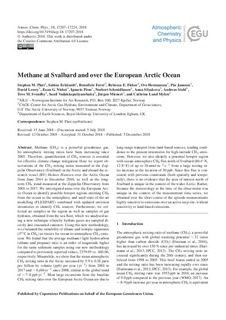| dc.contributor.author | Platt, Stephen Matthew | |
| dc.contributor.author | Eckhardt, Sabine | |
| dc.contributor.author | Ferré, Benedicte | |
| dc.contributor.author | Fisher, Rebecca E. | |
| dc.contributor.author | Hermansen, Ove | |
| dc.contributor.author | Jansson, Pär | |
| dc.contributor.author | Lowry, David | |
| dc.contributor.author | Nisbet, Euan G. | |
| dc.contributor.author | Pisso, Ignacio | |
| dc.contributor.author | Schmidbauer, Norbert | |
| dc.contributor.author | Silyakova, Anna | |
| dc.contributor.author | Stohl, Andreas | |
| dc.contributor.author | Svendby, Tove Marit | |
| dc.contributor.author | Vadakkepuliyambatta, Sunil | |
| dc.contributor.author | Mienert, Jurgen | |
| dc.contributor.author | Myhre, Cathrine Lund | |
| dc.date.accessioned | 2018-12-10T08:37:27Z | |
| dc.date.available | 2018-12-10T08:37:27Z | |
| dc.date.created | 2018-12-06T08:41:08Z | |
| dc.date.issued | 2018 | |
| dc.identifier.citation | Atmospheric Chemistry and Physics. 2018, 18 17207-17224. | nb_NO |
| dc.identifier.issn | 1680-7316 | |
| dc.identifier.uri | http://hdl.handle.net/11250/2576759 | |
| dc.description.abstract | Methane (CH4) is a powerful greenhouse gas. Its atmospheric mixing ratios have been increasing since 2005. Therefore, quantification of CH4 sources is essential for effective climate change mitigation. Here we report observations of the CH4 mixing ratios measured at the Zeppelin Observatory (Svalbard) in the Arctic and aboard the research vessel (RV) Helmer Hanssen over the Arctic Ocean from June 2014 to December 2016, as well as the long-term CH4 trend measured at the Zeppelin Observatory from 2001 to 2017. We investigated areas over the European Arctic Ocean to identify possible hotspot regions emitting CH4 from the ocean to the atmosphere, and used state-of-the-art modelling (FLEXPART) combined with updated emission inventories to identify CH4 sources. Furthermore, we collected air samples in the region as well as samples of gas hydrates, obtained from the sea floor, which we analysed using a new technique whereby hydrate gases are sampled directly into evacuated canisters. Using this new methodology, we evaluated the suitability of ethane and isotopic signatures (δ13C in CH4) as tracers for ocean-to-atmosphere CH4 emission. We found that the average methane / light hydrocarbon (ethane and propane) ratio is an order of magnitude higher for the same sediment samples using our new methodology compared to previously reported values, 2379.95 vs. 460.06, respectively. Meanwhile, we show that the mean atmospheric CH4 mixing ratio in the Arctic increased by 5.9±0.38 parts per billion by volume (ppb) per year (yr−1) from 2001 to 2017 and ∼8 pbb yr−1 since 2008, similar to the global trend of ∼ 7–8 ppb yr−1. Most large excursions from the baseline CH4 mixing ratio over the European Arctic Ocean are due to long-range transport from land-based sources, lending confidence to the present inventories for high-latitude CH4 emissions. However, we also identify a potential hotspot region with ocean–atmosphere CH4 flux north of Svalbard (80.4∘ N, 12.8∘ E) of up to 26 nmol m−2 s−1 from a large mixing ratio increase at the location of 30 ppb. Since this flux is consistent with previous constraints (both spatially and temporally), there is no evidence that the area of interest north of Svalbard is unique in the context of the wider Arctic. Rather, because the meteorology at the time of the observation was unique in the context of the measurement time series, we obtained over the short course of the episode measurements highly sensitive to emissions over an active seep site, without sensitivity to land-based emissions. | nb_NO |
| dc.language.iso | eng | nb_NO |
| dc.rights | Navngivelse 4.0 Internasjonal | * |
| dc.rights.uri | http://creativecommons.org/licenses/by/4.0/deed.no | * |
| dc.title | Methane at Svalbard and over the European Arctic Ocean | nb_NO |
| dc.type | Journal article | nb_NO |
| dc.type | Peer reviewed | nb_NO |
| dc.description.version | publishedVersion | nb_NO |
| dc.rights.holder | © Author(s) 2018. | nb_NO |
| dc.source.pagenumber | 17207-17224 | nb_NO |
| dc.source.volume | 18 | nb_NO |
| dc.source.journal | Atmospheric Chemistry and Physics | nb_NO |
| dc.identifier.doi | 10.5194/acp-18-17207-2018 | |
| dc.identifier.cristin | 1639722 | |
| dc.relation.project | Norges forskningsråd: 223259 | nb_NO |
| dc.relation.project | Norges forskningsråd: 225814 | nb_NO |
| dc.relation.project | Norges forskningsråd: SIS | nb_NO |
| dc.relation.project | NILU: 116005 | nb_NO |
| dc.relation.project | NILU: 118072 | nb_NO |
| cristin.unitcode | 7460,57,0,0 | |
| cristin.unitcode | 7460,52,0,0 | |
| cristin.unitname | Atmosfære og klima | |
| cristin.unitname | Måle- og instrumentteknologi | |
| cristin.ispublished | true | |
| cristin.fulltext | original | |
| cristin.qualitycode | 2 | |

